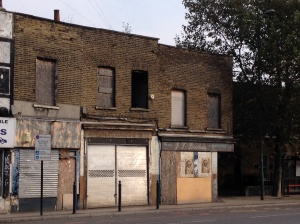A few weeks ago I had the pleasure of being invited into a corner of history that I hadn’t walked around in before. Behind a lifeless brick frontage and through the buzz and clang of blue security gates, it seemed an idyll of East End life survived just as it had done for generations.
Our church runs a monthly outreach project called Helping Hands. This involves visiting people who are unable to look after their own gardens any more due to age, illness, disability or any other reason. In groups of two or three we attack the tangled wilderness with sharp rusted implements until it is tamed and preferably still alive in some way. It is, as I’m sure you can imagine, hard work, very satisfying and more than a little treacherous. It is never boring because in my humble opinion nothing involving true East Enders ever is.
One such Helping Hands morning, Matt, Eli, myself and a lady who goes to our church visited a row of ground floor maisonettes on a road in Stepney. Despite the gentrification of a lot of areas in the east end, a lot of Stepney is largely the same as it was when it was redeveloped after over a third of the housing was flattened in the Blitz. Before this it was home to migrant workers and displaced poor and had a reputation for being a breeding ground for prostitution, overcrowding and violent behaviour. I tend to have a slightly heightened sensitivity to atmosphere but without wanting to be weird about it, I sometimes feel the history of it when I walk from street to street. Some areas even look like you could imagine they may have done before the war. Soot stained window frames and dark railway arches with sweaty, dripping wall moss. The lifeless face of a boarded up terraced house with a dandelion peeping through the letter box.
On this particular Sunday, we were invited into a modern housing complex only to be knocked sideways by the strength of the East End spirit hiding inside it. Doris, Mildred and Winifred (‘call me Winnie’) strong women of the ‘older’ East End contingent, all occupying houses adjacent to each other, their gardens only separated by the flimsiest of rusted fencing (though apparently not too flimsy to lean on nonchalantly whilst commenting on each other’s business).
As the morning passed we witnessed a very comfortable little community; drinking tea, hanging up laundry, furry slippers with painted toenails peeping out the ends and all with the standard mixture of dry wit, tough love and mockery to go with it. Although we were gardening with our hands our minds and ears were completely elsewhere as we listened to the life stories of these women. This included a complex web of family members, friendship politics, a son who stayed and stayed and wouldn’t get a job, the arrival of a grandchild weighing only one pound, a beloved yappy dog who enjoys plant pots so much he literally obliterated one into tiny shards as Eli looked on in frozen horror. ‘He just LOVES them!’ says Mildred adoringly.
As we left, Winnie caught us up to have a little word about Doris whose garden we had been working on. when she reached us she stopped to look gravely at me beneath her eyebrows and adopted a conspiring, hushed tone. ‘I spent two hours doing Doris’ garden just last week. I’ve ‘ad me ‘ip replaced ‘n everyfin. Coupla days later I look over and it’s exactly like it was before! Blahdy waste of time…’ I looked at her and said ‘mmm’ because I wasn’t totally sure what else to say having just spent two hours doing Doris’ garden. At that she turned in her slippered feet and walked slowly back towards her garden, secure in the knowledge that she had passed on all the relevant information. I just watched her go, vaguely wishing I could come and hang out with them every afternoon.




